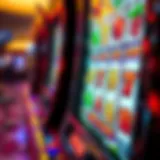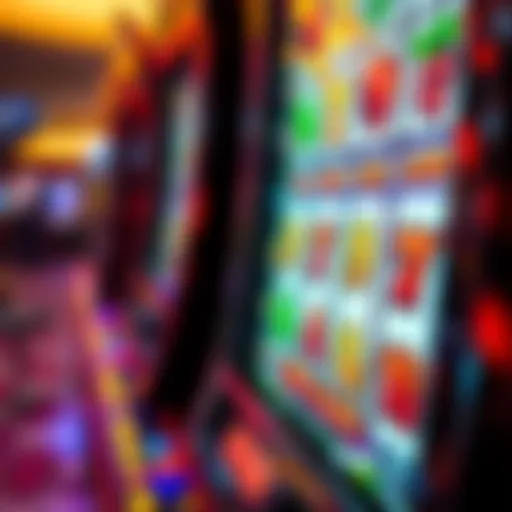Converting Percentages to Probabilities Explained


Intro
In the realm of gambling, understanding numbers is paramount. Whether you're perched at a poker table or spinning the roulette wheel, grasping the concepts of probability and percentages can tilt the odds in your favor. This article will explore how to translate percentages into probabilities using a % to probability calculator, shedding light on the math behind the magic. This conversion isn't just a mere academic exercise; it plays a crucial role in shaping strategies and enhancing decision-making in gaming scenarios.
Game Strategies
When it comes to casino games, having a well-thought-out strategy can be the difference between a night of fun and a deep hole in your wallet. Knowing how to convert percentages to probabilities allows players to make more informed decisions. Let's break down some vital game strategies that leverage this knowledge.
Essential Tips for Winning
- Know the Odds: Familiarize yourself with the odds of specific games. For instance, if a roulette bet has a winning chance of 35%, you can easily find the equivalent probability—0.35. This understanding helps in determining how much to wager.
- Bankroll Management: Set aside a specific percentage of your total bankroll for each game session. This percentage can guide your betting size based on the probabilities of your chosen bets. A smart player tailors their bets to match their level of risk tolerance.
- Practice Makes Perfect: Use free online games to practice. Familiarizing yourself with the probabilities can aid in transforming theoretical knowledge into skilled play.
- Avoid Betting Systems: Many swear by systems that promise victory. However, recognizing the odds behind each bet and understanding fluctuations in probabilities is more beneficial than chasing after a dubious strategy.
Advanced Techniques for Experienced Players
Once you have a grip on the basics, integrating more complex strategies can elevate your game:
- Dynamic Betting: As you play, update your knowledge on probabilities and adjust your bets accordingly. If the chances of winning dwindle, you might want to reduce your stake to mitigate losses.
- Card Counting in Blackjack: This infamous technique relies on calculating the ratio of high to low cards remaining in the deck. Understanding these probabilities can provide a tactical edge when deciding whether to hit or stand.
- Game Theory Application: Advanced players can employ game theory to make strategic decisions, especially in poker. This mathematical framework assesses the probabilities of opponents’ potential hands and allows you to navigate through competitive scenarios more effectively.
Industry Insights
The gambling landscape is dynamic, influenced by trends, regulations, and evolving player behavior. Staying informed is crucial for anyone vested in this realm.
Latest Trends in Casino and Poker
Casinos are increasingly incorporating technology to enhance the player experience. From mobile apps that calculate probable outcomes to immersive gaming technologies that simulate real-life scenarios, understanding how these trends affect the probabilities can influence your gaming decisions. Besides, online poker communities keep buzzing with discussions on strategic approaches, so engaging with these platforms can yield valuable insights.
Regulatory Changes and Their Impact on Gamblers
Regulatory shifts can change the framework within which players operate. For example, changes in licensing and tax regulations can affect how casinos manage odds and payouts. Keeping an eye on government publications can be beneficial for any serious player. Websites like nass.org provide vital updates on state regulations that shape the gambling landscape.
"Understanding the landscape's evolution is as crucial as understanding the game itself."
Preface to Percentage and Probability
Understanding the concepts of percentage and probability is fundamental in numerous areas, especially when it comes to making decisions about risk in gambling settings. This section lays the groundwork for comprehending how these two mathematical tools work together, offering gamblers the ability to analyze situations effectively. Knowing how to calculate one from the other is crucial to refining strategies and enhancing overall performance at the casino or in sports betting.
Defining Percentage
A percentage is a way to express a number as a fraction of 100. We often encounter this term in daily life, from sales discounts to statistical data in sports. For example, if a roulette wheel has one winning segment out of thirty-eight, it can be expressed as approximately 2.63%. The beauty of percentages lies in their ability to simplify comparisons across different contexts. It's a universal language in statistics and finance.
To further illustrate, consider a scenario where a poker player wins 3 out of 10 games. The player’s winning percentage is 30%. This quantifiable metric allows for clear insight into performance, making it easier to measure progress or assess competition. Essentially, percentage serves not just as a value but also as a benchmark for success.
Defining Probability
Probability, on the other hand, measures how likely an event is to occur and is expressed as a number between 0 and 1 or as a fraction. A probability of 0 means an event will not happen, while a probability of 1 means it will certainly occur. Let’s say in a game of blackjack, the probability of being dealt an Ace as the first card is roughly 4 out of 52 or about 0.077 (which is 7.7%). This gives players an idea of their chances without needing extensive calculations.
Like percentage, probability is a powerful tool in the gambler’s arsenal. It helps in evaluating risks and potential returns, allowing informed choices that might tip the balance in favor of the player.
The Relationship Between Percentage and Probability
The relationship between percentage and probability is intimate. They are two sides of the same coin. To convert a probability into a percentage, one simply multiplies the probability by 100. For instance, a probability of 0.25 translates to 25%, indicating a one in four chance of an event occurring. Conversely, to calculate probability from a percentage, you divide by 100, turning that 25% back into a probability of 0.25.
This interplay between the two metrics is especially useful in gambling scenarios, enabling players to assess odds in a familiar format. Understanding this relationship means bettors can analyze games more strategically, which is vital in the high-stakes world of casinos and betting. Thus, developing a solid grasp of both percentages and probabilities not only enhances analytical skills but significantly contributes to more calculated decision-making at the gaming table.
Mathematical Foundations
Understanding the mathematical framework behind percentage and probability conversions is essential for anyone involved in gaming, particularly gamblers, casino professionals, and poker players. Grasping these concepts not only reinforces analytical thinking but also enhances decision-making capabilities under uncertainty. As risk management is a significant factor in gambling scenarios, acknowledging the role of foundational mathematics paves the way for more informed strategies and plays.
Basic Concepts in Mathematics


Before delving into percentages and probabilities, it's prudent to revisit some key concepts in mathematics. Familiarity with basics such as addition, subtraction, multiplication, and division is paramount. These operations form the building blocks for more complex calculations.
A few core ideas to bear in mind:
- Numerical Values: Understanding whole numbers, fractions, and decimals is crucial. Each representation serves a different purpose in probability calculations.
- Order of Operations: Known as PEMDAS/BODMAS, this dictates how calculations should be configured to achieve the right results.
- Order of Magnitude: Recognizing the scale of numbers can help in deciding which approach to use when dealing with probabilities in different betting scenarios.
This strong foundation allows individuals to navigate larger calculations and more complex formulas involving percentages and probabilities with ease.
Understanding Fractions
Fractions play a pivotal role in expressing both probabilities and percentages. At their core, fractions consist of two parts: a numerator and a denominator. In gambling, these fractions can represent the likelihood of specific events occurring, like flipping a coin or drawing a winning card from a deck.
To clarify:
- Numerator: Represents the number of successful outcomes. For instance, if you're analyzing a game that requires drawing one specific card from a standard deck of 52 cards, the numerator is 1 (the winning card).
- Denominator: Represents total possible outcomes. In the aforementioned card example, the denominator would be 52, as there are 52 cards in total.
Thus, the fraction representing this probability would be 1/52. Understanding how to manipulate these fractions is key to shifting between percentages and probabilities effectively.
Expressing Probabilities as Fractions
Expressing probabilities as fractions is a straightforward but essential step in the overall probability calculations that players often encounter. Probabilities convey the chance of an event occurring within a defined context, and expressing them as fractions helps to visualize the overall landscape of possible outcomes.
- Converting Odds to Probability: If someone says the odds for winning a game are 3 to 1, the probability is expressed as the fraction of 3 out of 4 total outcomes—3 wins and 1 loss. This binds into the concept where we turn this into a percentage by multiplying the fraction by 100.
- Example of Probabilities: In a simple dice game, where rolling a six is desired, the probability can be calculated as follows:
- Successful outcomes (rolling a six) = 1
- Total outcomes (the six sides of the dice) = 6
- Probability = 1/6
Understanding this conversion method and the ability to articulate probabilities as fractions clarifies decision-making processes.
"Understanding the nuances of probability not only sharpens your analytical skills but also empowers more strategic risk management in betting."
Converting Percentage to Probability
Converting percentage to probability is a crucial skill, especially for those who find themselves engrossed in the world of gambling and chance. This process can mean the difference between making informed betting choices and following hunches that lead to losses. At its core, the conversion allows gamblers to assess risks and rewards, making it easier to evaluate potential payoffs in various scenarios. Understanding how to translate percentages into probabilities can enhance one's strategic thinking and ultimately lead to more favorable outcomes in games.
The Conversion Formula
The underpinning formula for converting percentage into probability is quite straightforward:
[ P = \fracpercentage100 ]\
Here, P represents the probability expressed as a decimal. This formula clarifies that a percentage, which is inherently a form of expressing a part of a whole, can be effectively turned into a probability—an essential concept for decision-making in betting and other scenarios involving chance.
For example, if a roulette game indicates there’s a 30% chance of hitting red, using the conversion formula gives us:
[ P = \frac30100 = 0.3 ]
This means the probability of hitting red is 0.3, or 30%, providing a concrete number to work from during gameplay.
Step-by-Step Conversion Process
Let’s break down the steps necessary to perform this conversion for utmost clarity:
- Identify the Percentage: Start with the percentage you want to convert. Make sure it's clearly defined.
- Apply the Conversion Formula: Use the formula ( P = \fracpercentage100 ) to perform the conversion.
- Check Your Work: Always double-check the math. A slight miscalculation can lead to significant misjudgments in a betting game.
- Interpreting the Result: Finally, interpret what this probability means in the context of your gaming strategy.
To illustrate, if you have a game where there’s a 45% chance of winning, using these steps:
- Identify: 45%
- Apply: 45 / 100 = 0.45
- Check: Correct
- Interpret: There’s a 45% chance you will win, a substantial figure to consider while making bets.
Common Conversion Examples
Understanding these conversions becomes immensely practical when we look at familiar examples from various games:


- Blackjack: If a player has a 20% chance to hit a blackjack, converting gives us 0.2. This notably reflects a 20 out of 100 interactions leading to success.
- Slot Machines: When a machine advertises a 15% payout probability, applying the formula results in 0.15. Hence, betting on such a machine carries a lower likelihood of return compared to others.
- Poker: If a player calculates a 50% chance of winning a hand, it translates to probabilities of 0.5, meaning they should win approximately half the time overtime.
- Sports Betting: A team with a 70% probability of winning a match translates to a probability of 0.7. This can sway bets significantly in their favor.
Each example underscores the value of mastering these conversions—not only does it enrich your understanding of percentages versus probabilities, but it also sharpens your decision-making acumen at the gaming table.
Learning to convert percentages to probabilities can enhance strategic decision-making, providing clarity in situations filled with uncertainty.
By grasping these concepts, you position yourself better when engaging with games, ultimately steering your choices towards calculated risks and informed predictions.
Using a Percentage to Probability Calculator
In the ever-evolving landscape of gambling and betting, understanding the crucial interplay between percentage and probability becomes a necessity rather than a choice. A percentage to probability calculator serves as an invaluable tool for players looking to make informed decisions in their gaming endeavors. The tool simplifies the conversion process, effectively transforming abstract percentages into clear-cut probabilities that can dictate strategy and outcome assessments. This section will delve into the significance of these calculators, shedding light on the various facets that enhance their relevance in the gaming sphere.
Overview of Online Calculators
Online calculators designed for converting percentages to probabilities are relatively easy to find. Many websites offer these calculators as a free resource, enabling quick and efficient calculations without the need for extensive mathematical know-how. By simply entering a percentage, users can instantly obtain the corresponding probability. This kind of accessibility means that even those who struggle with math can operate effectively within their betting environments. Furthermore, numerous calculators come equipped with additional features, such as visual representations of odds, which provide a more comprehensive understanding of probability in various scenarios.
Advantages of Using a Calculator
Time Efficiency
Time efficiency is perhaps one of the most compelling reasons why players lean towards using these calculators. When sitting at a poker table or deciding on a casino game, every second counts. Rather than manually calculating probabilities—an often tedious and potentially error-prone process—users can quickly input a percentage and receive an answer in an instant. This rapid conversion allows players to focus more on the actual gameplay rather than getting bogged down in the math. The beauty of time efficiency lies in its ability to streamline decision-making, which directly correlates with one’s success rate in competitive scenarios.
Reduced Human Error
Even the sharpest minds can trip over their own calculations at times, which brings us to the concept of reduced human error. Relying on a calculator eliminates the guesswork that often plagues manual computations. By outsourcing the mathematical legwork, players significantly minimize the risk of miscalculating, which can lead to poor betting decisions. This precision is particularly essential in gambling environments, where the stakes are high and a small error can mean a great loss. When using an online calculator, you can trust the accuracy of the results, allowing you greater confidence in your strategic choices.
Limitations of Online Calculators
While online calculators have their benefits, it's crucial to acknowledge that they are not without limitations. Most notably, these tools rely entirely on the input provided by the user. If the percentage entered is incorrect, the corresponding probability will also be wrong. Moreover, online calculators often lack the depth needed for more complex probabilistic scenarios, which could render them less useful for advanced players or those dealing with multifaceted betting strategies. They also might not account for external factors such as situational variables or changing odds, which can significantly influence the actual probability in a given gaming scenario.
It is essential, therefore, for players to not depend solely on calculators, but to also strengthen their understanding of probability and the underlying mathematics through continuous learning.
In summary, while using a percentage to probability calculator can considerably ease the burden of calculations and enhance strategic decision-making, it's wise for gamblers to blend this tool with critical thinking and mathematical understanding to maximize success in their gaming pursuits.
Practical Applications in Gambling
The intricate relationship between probability and gambling is as old as the games themselves. By confronting the chaos of chance with calculated odds, players can potentially tilt the scales in their favor. In this section, we will explore why understanding practical applications of probability in gambling is crucial. It is about more than just luck; it’s a strategy for informed decisions.
Probability in Casino Games
In the realm of casino games, probability plays a pivotal role. Each game, be it blackjack, roulette, or poker, is built upon a framework of odds that dictate potential outcomes. For example, when playing roulette, a player's chances of winning on red or black are roughly 47.37%. This probability gives players a clearer expectation of outcomes.
In actuality, seasoned gamblers leverage probability to navigate their choices during gameplay. They might assess the risks involved with certain bets versus others. By knowing the odds, they can decide whether to play more conservatively or take a chance on a high-risk, high-reward option. Understanding the math behind these probabilities often separates the casual player from the serious gambler.
Strategic Decision-Making
Understanding Risks
The concept of risk is integral in strategic decision-making in gambling. It's not merely about winning or losing but recognizing when to hold em and when to fold. A player who understands the risks involved can make educated choices. By using percentage-to-probability calculations, gamblers can determine how much they are willing to stake against potential returns.
This understanding allows for a more nuanced approach. Instead of simply chasing losses with reckless bets, informed players can adjust their strategies based on calculated risks. They can weigh their chances, alter their stake sizes, and set limits, ultimately leading to a more sustainable betting practice.
Maximizing Returns
Maximizing returns isn’t just about picking the right numbers or cards; it’s about using probability strategically. Every gambler dreams of hitting the jackpot, but success often hinges on understanding how to maximize the potential returns on their investment.
For instance, in a game like poker, knowing the probability of certain hands winning can significantly influence a player’s strategy. If a player knows they have a 20% chance of winning and the pot is large enough, it might be worth the investment. However, the unique feature here is weighing the potential gains against the risk. This analytical lens allows bettors to make those tough calls, adding a layer of depth that relies on probability calculations.
Betting Strategies Informed by Probability


Betting strategies are not just random acts of chance; they can be systematic and grounded in mathematical probability. Players who harness data effectively can develop strategies that better their odds. Many seasoned gamblers utilize systems like the Martingale or Fibonacci strategies, modifying their bets based on previous outcomes and the probabilities associated with them.
Impact on Game Theory
Understanding the relationship between probability and percentages is not just an academic exercise. It’s fundamental to informed decision-making, especially in gaming scenarios. Game theory, the study of strategic interactions among rational decision-makers, provides the framework for applying these mathematical concepts in practical, often high-stakes situations.
The importance of game theory in gambling and decision-making arises primarily from its emphasis on predicting outcomes based on player behavior and risk assessment. Players must constantly gauge not only their chances of winning but also how opponents might react to their moves. By grasping these dynamics, players can make better strategic choices, thus improving their potential return on investment. This section breaks down some of the core ideas of game theory and how they interplay with probability calculations.
Game Theory Fundamentals
At its core, game theory is about making choices in the presence of others. It’s a mathematical framework that deals with competitive situations, where the outcome for each participant depends on the choices of all involved. Key elements of game theory include:
- Players: Individuals or entities making decisions, often in competition.
- Strategies: The plan of action adopted by players based on what they believe others will do, along with their probabilities of winning.
- Payoffs: The rewards or outcomes resulting from the various strategies employed.
For instance, consider a poker game where two players are vying for the pot. Each player calculates their own likelihood of winning based on their hand and their assessment of the opponent's potential hands. Understanding the odds of winning not only helps a player decide whether to bluff or fold, but it also lays the groundwork for anticipating the opponent’s strategy and adjusting accordingly.
Probability as a Game Theoretic Tool
When it comes to making decisions, probability serves as an essential tool within the game-theoretic framework. Here's how:
- Informed Choices: Players can convert percentages that represent their likelihood of winning into actionable probabilities, allowing them to make decisions based on expected outcomes. For example, if a player knows they have a 75% chance of winning a hand, they might choose to bet aggressively.
- Risk Assessment: Understanding the probabilities involved in different game scenarios empowers players to evaluate the risks they are taking. A player might find it prudent to play conservatively against an opponent who frequently bluffs, thereby maximizing their own expected payoff.
- Strategic Adaptability: As the game progresses, probabilities can shift based on new information. Players who adeptly manipulate their understanding of probabilities are often more successful in adapting their strategies in real-time.
In summary, game theory not only helps players decipher the underlying dynamics of competition but also bridges the gap between theoretical probability and practical application in gambling scenarios. It empowers players to think critically about their strategies and enhances their ability to navigate complex decision-making processes. By understanding the role of probability within this framework, gamblers can make more informed choices, significantly impacting their gameplay and potential winnings.
Case Studies in Gambling Scenarios
Analyzing gambling strategies through past scenarios provides insight that can be crucial for making informed decisions. Case studies act as a compass, guiding gamblers in understanding how different probabilities can influence outcomes. They showcase real-life applications of probability theories and the impact of calculated risks in gambling contexts. The importance of these case studies cannot be overstated; they help align theoretical knowledge with practical experience, enabling players to refine their strategies and mitigate losses.
Analyzing Past Games
When we observe past games, what we are really doing is peeling back the layers of probability in action. Each game played is a unique instance where odds are at play, and analyzing these instances allows gamblers to understand how different factors, like player behavior and game conditions, can sway outcomes.
For example, take the game of blackjack. Analyzing historical rounds — such as the frequency of certain card combinations or the changing dynamics when switching to different decks — can provide vital clues to the expected probability of winning as the game progresses. Here are some elements to consider:
- Player Decisions: The choice to hit or stand alters the probabilities significantly. By studying past player decisions, valuable insights can emerge about 'optimal play' in specific situations.
- Dealer's Up Card: Past games often reveal patterns associated with the dealer’s exposed card. Knowing when to play aggressively or cautiously can come from thoroughly understanding these probabilities.
- Shoe Penetration: Gambling theory often highlights how deep into the deck you are in blackjack affects odds. Historical analysis can show trends when shoes run high or low.
By engaging with these past games through mathematical frameworks, gamblers can uncover strategies grounded firmly in probabilities. As intelligent players know, past performance does not guarantee future success, but failing to analyze can lead one down a slippery slope of poor decision-making.
Learning from Probabilistic Outcomes
The ultimate takeaway from analyzing case studies is the learning that comes from probabilistic outcomes. Each game that's observed adds a new layer of understanding to how chance plays out in gambling scenarios. By carefully examining these outcomes, one can draw effective conclusions that often translate into better decision-making in future bets.
- Understanding Variance: Variance is a critical concept for any gambler to grasp. Reflecting on results from various games reveals which outcomes are statistical anomalies and which align with expected probabilities.
- Adjusting Strategies: Case studies can highlight when to alter betting strategies. For instance, if past data shows that a strategy performs poorly under certain conditions, a gambler might reconsider their approach or switch tactics.
- Psychological Insights: Understanding psychological factors in play also provides a richer context. Observing emotional reactions and their impact on choices can inform players about when other gamblers are likely to take risks.
Successful gambling relies not just on luck but on a deep understanding of probability and human behavior.
Closure: The Significance of Probability Calculations
In the world of gambling and gaming, understanding how to accurately convert percentage figures into probabilities carries significant weight. It’s not just about crunching numbers; this understanding can influence strategies and decisions, shaping outcomes in a person's favor. With knowledge of probability calculations, one can approach games with greater confidence and precision, an invaluable trait in high-stakes environments.
Recap of Key Insights
Throughout our exploration, we have established a few foundational principles. First off, the intricate relationship between percentage and probability is critical. Knowing that 50% translates directly to a probability of 0.5 can be a game-changer—whether you're betting on a single hand in poker or wagering on the outcome of a sports event.
We discussed the transition from percentages to probabilities and how a percentage to probability calculator serves as an essential tool in this mathematical conversion. The steps outlined in our guide emphasize that even minor errors in our calculations can lead to major losses in gambling contexts. Utilizing calculators streamlines this process, reducing human error while saving valuable time.
"In gambling, knowledge is power—understanding your probabilities could mean the difference between winning big or losing it all."
Moreover, we analyzed real-world applications and case studies that illustrate the effectiveness of probability in making informed decisions. Players armed with these insights can optimize their betting strategies, choosing where to place their chips with enhanced certainty.
Future Implications in Gaming
As we look ahead, the role of probability calculations in gaming is poised to grow. With advancements in technology and data analytics, gamblers will likely have even more sophisticated tools at their disposal. These tools will not just rely on rudimentary conversions but may incorporate machine learning algorithms to predict outcomes based on historical data.
Furthermore, understanding these probabilities deeply can lead to a shift in instructional approaches for new players. Casinos, recognizing that informed gamblers make for a more engaging environment, might even begin to offer tutorials or resources focusing on the mathematical aspects of their games. This evolution could foster a new wave of savvy players adept at leveraging probabilities to their advantage.
Ultimately, the significance of probability calculations is evident. They inform not just personal gaming strategies but broader industry trends as well. As players refine their skills and instructors adapt their teachings, the landscape of gaming will continue to evolve, rooted in the foundational principles of percentages and probabilities.







